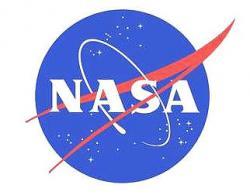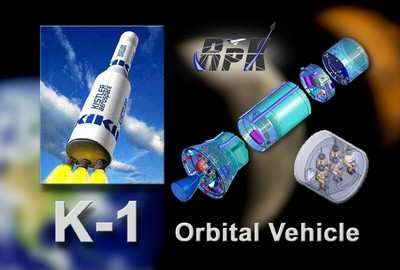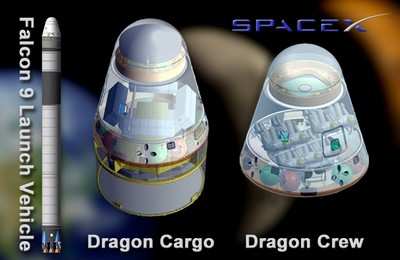NASA Invests in Private Sector Space Flight with SpaceX,
Rocketplane-Kistler
 As noted in ANN's
coverage last Friday, NASA is making an unprecedented investment in
commercial space transportation services with the hope of creating
a competitive market for supply flights to the International Space
Station (ISS).
As noted in ANN's
coverage last Friday, NASA is making an unprecedented investment in
commercial space transportation services with the hope of creating
a competitive market for supply flights to the International Space
Station (ISS).
Two industry partners will receive a combined total of
approximately $500 million to help fund the development of
reliable, cost-effective access to low-Earth orbit. The agency is
using its Space Act authority to facilitate the demonstration of
these new capabilities. NASA signed Space Agreements Aug. 18 with
Space Exploration Technologies (SpaceX) of El Segundo, Calif., and
Rocketplane-Kistler (RpK) of Oklahoma City to develop and
demonstrate the vehicles, systems, and operations needed to support
a human facility such as ISS. Once the space shuttle is retired,
NASA hopes to become just one of many customers for a new,
out-of-this-world parcel service.
The venture marks a break with tradition for the 48-year-old
space agency. “This is the first opportunity NASA has taken
to engage entrepreneurs in a way that allows us to satisfy our
needs and lets commercial industry gain a foothold. It could, and
should, have profound impacts on the way NASA does business,”
said Marc Timm, acting Commercial Orbital Transportation Services
(COTS) Program executive in NASA’s Exploration Systems
Mission Directorate.
Alan Lindenmoyer, manager of the Commercial Crew and Cargo
Program Office at NASA's Johnson Space Center, said NASA's offer of
seed money fulfills President Bush's Jan. 14, 2004 directive to
promote commercial participation in space exploration. The 2005
NASA Authorization Act also calls on the agency to advance space
commerce. "We are directly tied to the Vision for Space Exploration
and the law of the land," Lindenmoyer said. "COTS marks a
significant NASA activity to implement the commercialization
portion of U.S. space policy."

The demonstrations are scheduled to begin as early as 2008 and
continue through 2010 or later. COTS will be carried out in two
phases. Phase 1, unveiled Aug. 18, will include safe disposal or
return of spacecraft that successfully dock at ISS and deliver
cargo. A follow-on option to demonstrate crew transportation also
is planned. Once demonstrated, NASA plans to purchase
transportation services competitively in Phase 2.
Partners will be paid only if they succeed. Payments will be
incremental and based upon the partners' progress against a
schedule of performance milestones contained in each Space Act
agreement. The agreements were tailored to the individual partners
and negotiated before partnership selections were made. NASA will
gauge progress through site visits and milestone achievements.
Usually, the space agency issues detailed requirements and
specifications for its flight hardware and it takes ownership of
any vehicles and associated infrastructure that a contractor
produces. For COTS, NASA specified only high level goals and
objectives instead of detailed requirements where possible, and
left its industry partners responsible for decisions about design,
development, certification and operation of the transportation
system. Because NASA has a limited amount of money to invest, it
encouraged the partners to obtain private financing for their
projects and it left them free to market the new space
transportation services to others.
This model for pursuing of commercial space services is another
first for NASA and a reflection on the growing maturing of
commercial space capabilities. "This is not a traditional NASA
procurement or program. We could change the economics of space
flight with this," said Lindenmoyer, whose office oversees COTS.
NASA expects use of this model to increase over time as the
exploration program unfolds, potentially extending to the provision
of power, communications, and habitation facilities by commercial
entities.

Limited resources and the space shuttle's pending retirement
created the need for the new service, and the emergence of enabling
technology has created a favorable environment for COTS
development, according to Timm. Industry interest was keen, with
nearly 100 companies submitting expressions of interest and 20
companies submitting initial proposals.
NASA expects that purchasing commercial space transportation
services will be more economical than developing government systems
of comparable capability. This could free up additional resources
for lunar missions and other activities beyond low-Earth orbit.
The biggest benefit of the anticipated cost savings is the
opening of new markets for an emerging industry, according to
Lindenmoyer. "If we had cost-effective access, many new markets --
biotechnology, microgravity research, industrial parks in space,
manufacturing, tourism -- could start to open. That's what is so
important about this effort."
 Airborne 05.19.25: Kolb v Tornados, Philippine Mars, Blackhawk Antler Theft
Airborne 05.19.25: Kolb v Tornados, Philippine Mars, Blackhawk Antler Theft Airborne 05.23.25: Global 8000, Qatar B747 Accepted, Aviation Merit Badge
Airborne 05.23.25: Global 8000, Qatar B747 Accepted, Aviation Merit Badge ANN's Daily Aero-Term (05.23.25): On-Course Indication
ANN's Daily Aero-Term (05.23.25): On-Course Indication Aero-News: Quote of the Day (05.23.25)
Aero-News: Quote of the Day (05.23.25) ANN's Daily Aero-Linx (05.23.25)
ANN's Daily Aero-Linx (05.23.25)





